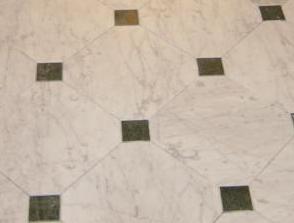Marble Flooring
Marble flooring is commonly provided in places of worship (temples, churches, mosques, gurudwaras etc.) and in public buildings having rich specifications. In view of high cost of material, use of marble flooring in residential buildings in normally restricted to areas like kitchen, bath room, entrance etc.
The size of marble slabs to be used in flooring depends upon the pattern to be- adopted. The slabs for normal works are square or rectangular in shape and their thickness varies from 20 mm to 40 mm. The marble flooring is laid on prepared sub-grade of concrete or on the R.C.C. floor slab. Prior to laying flooring, the sub-grade in cleaned, wetted and mopped properly. A layer of bedding mortar which can be 1:4 cement mortar (1 cement :4 coarse sand) or lime mortar (1 lime putty : 1 surkhi /coarse sand) is spread in average thickness of about 20 mm under the area of each slab. The marble slab is laid on top of the bedding mortar, pressed and tapped with wooden mallet and brought to the level with the already laid adjoining slabs. The slab is thereafter lifted up and placed aside. The top surface of the bedding mortar is then corrected by adding mortar at hollows. After the bedding mortar is hardened slightly, cement slurry is spread over the same at the rate of 4.4 kg of cement per sq m. The edges of the slab already laid are then smeared with cement slurry of the same shade as that of the marble slab and the slab to be paved is again placed in position and tapped with wooden mallet till it is properly bedded in level with the adjoining slabs. The joint between two slabs has to be very fine (paper thick). The cement that oozes out of the joint is cleaned. Remaining slabs are also laid in the same manner and until the flooring work is completed. The paved area is cured for a minimum period of seven days.

